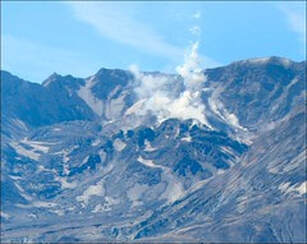|
All rocks are one of three basic types - igneous, sedimentary, or metamorphic. Even though these words sound complicated, it is really pretty easy to see what they mean, by modeling what happens when different types of rocks are formed. And, even though we could do that with clay or playdough, it is much more fun to do it with something we can eat! Let’s make some chocolate rocks! Click and expand the tabs below to get started. what you'll need
experimental procedure
what's happening
All rocks on Earth are made in one of these three ways - either by melted rock cooling (igneous), by pieces of broken rocks being compressed together (sedimentary), or by rocks being compressed and heated (metamorphic). This is called the rock cycle, because a rock could start out as an igneous rock, be broken into bits by wind and water, be compressed and turned into a sedimentary rock, then be buried deep underground by an earthquake or other natural disaster, and then be changed into a metamorphic rock. Scientists called geologists study the different types of rocks and can tell, just by looking at a rock, if it is igneous, sedimentary, or metamorphic, based on how it looks and where it is found. variations and related activities
Since the rock cycle takes millions of years, it is much easier to model it with other things, rather than using real rocks! Here are some other ways to understand the rock cycle and how it works. This experiment is adapted from an experiment that we posted on our Facebook page July 17. Here is the link to the original, from the Fernbank Museum: https://youtu.be/7UDjqOe9arU Here’s one that uses crayons: https://littlebinsforlittlehands.com/crayon-rock-cycle Here’s another one, using Starburst candy. Notice - this one needs adult help, because it involves melting the candy: https://lemonlimeadventures.com/edible-rock-cycle-for-kids/ This one uses either grated chocolate, or grated crayons (don’t do both together!): https://www.mos.org/sites/dev-elvis.mos.org/files/docs/education/mos_geology-rock-detectives_diy-rock-cycle.pdf references and links to more information
This article has simple, kid-friendly language about rocks and how they form: https://www.ducksters.com/science/rocks.php This article, from National Geographic, is very clear and concise. [NOTE: You might have to sign up for a free National Geographic membership to view this one]: https://www.nationalgeographic.com/science/earth/inside-the-earth/rocks/ If you’d like to jazz it up, here is the same information in a rap song: https://youtu.be/G7xFfezsJ1s The Colorado School of Mines in Golden has a very cool museum, which teaches about geology in a number of neat ways. Of course, they are closed right now, but they do have kits which are available for checkout, if you want to learn more! Check it out here: https://www.mines.edu/museumofearthscience/
Return to Main Menu
0 Comments
We have all made volcanoes with baking soda and vinegar. But this volcano will teach you more about different things that come out of a volcano, and how they work together to build the volcano over time. NOTE: This is best done outside - it is very messy!!! Experimental Procedure:
What’s Happening? When a volcano erupts, it spews out lava. We all know this. But, not all lava is the same. Some lava has more gas dissolved in it than other lava does, and so it acts differently when it cools. Since these two different types of lava were first discovered in Hawai’i, they have Hawaiian names - aa (aah-aah) and pahoehoe (pah-hoy-hoy). The kitty litter that you sprinkled around the volcano represents aa lava. If you look at the kitty litter closely, what do you see? You should notice that kitty litter is made up of little chunks of material that are kind of sharp and pointy. That is what aa lava is like, after it has cooled. It is sharp and pointy, and when you step on it, it sounds like glass breaking. Think of stepping on something sharp with your bare feet - you might say “Aah!”. That is one way to remember aa lava. The other kind of lava is represented by the molasses. When you poured the molasses out of the jar or bottle, you probably had a stream of it running down onto the volcano. When you look at this stream more closely, you might notice that it is smooth and it flows easily. The other kind of lava that we are talking about, pahoehoe lava, acts more like molasses. It flows smoothly, and cools into smooth, wavy patterns. When volcanoes erupt, sometimes the lava that comes out is aa, and sometimes it is pahoehoe. Sometimes, no lava at all comes out, and instead there will be ash, or even half-melted rocks! But, whatever comes out of the volcano, when it stops moving, it becomes part of the side of the volcano. Volcanoes actually grow every time they erupt! That is why your volcano is wider at the end of the activity than it was at the beginning. Variations and Related Activities: To actually see the buildup of gas pressure that leads to an eruption, put baking soda and vinegar in a zip-top bag, zip the top, and then put it on the ground and back up to watch it expand and pop. Of course, it is also interesting to see how little baking soda it takes to make the volcano erupt, and if all the baking soda is used up in any one eruption. Links to more information and activities: Lava articles with photos of aa and pahoehoe lava: More interesting volcano facts: There is actually one volcano that scientists were able to watch being started! To read more, and see some amazing pictures, go here: You can also listen to the book Hill of Fire, and learn more about volcanoes on this Reading Rainbow episode:
Experimental Procedure:
What's Happening?: What you have just made is a simple version of what is happening inside the Earth all the time. The bottom graham cracker represents the core of the Earth. The icing represents the magma - melted rock that is in between the core and the tectonic plates. The top graham cracker pieces represent the tectonic plates. The tectonic plates (tectonic means things that happen on the surface of the Earth) float around on this melted rock and move in different ways, which we just demonstrated. When the plates run into each other and push each other up, that is convergence, and it can cause mountains and volcanoes to form. When the plates run side by side, sometimes they stick and slip. The slipping is when earthquakes happen. Of course, there are many other things that happen in the Earth’s crust, too, but this is a good place to start. Variations and Related Activities: Making a volcano - We have all made volcanoes with baking soda and vinegar. But, you can take the process two steps further by making layers of different kinds of lava on your volcano. Check out another Cool activity to make a volcano with simulated aa and pahoehoe lava. Links to more information and activities: See where the latest earthquakes have happened, and what magnitude they were: Watch live webcams from Kilauea volcano in Hawai’i:
|







